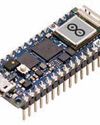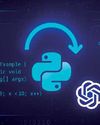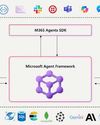Python 3: Features Every Developer Should Know Of
Open Source For You
|June 2025
Here's a review of some of the most significant features and enhancements introduced in Python 3, responsible for making it the programming language that developers love to work with.

Python 3 was first released in 2008 with the aim to end the long-standing inconsistencies found in Python 2, the earlier version of the programming language. However, for years, it had gaps in toolchains, unsupported libraries, and legacy code making developers unwilling to migrate to it. The tide turned in January 2020 when the sun set on Python 2. From then on, Python 3 has become the preferred and the sole maintained and supported version of Python.
Today, Python 3 is used widely. Libraries and frameworks are designed and built using Python 3 — from Django and Flask to NumPy and TensorFlow. Schools don’t teach anything except Python 3. Every new release of the language continues to enhance its performance and readability. New error-reporting schemes and support for modern programming practices have helped Python 3 secure its position as the default platform for all forms of software development.
Clean and consistent syntax Python 3 focuses on clarity and consistency. Much of its development has come in the form of improvements to the fundamental syntax elements that form the core of the language. Eliminating certain ambiguities allows one to write code that is easy to maintain. Here are a few code comparisons that show how Python 3 is a major syntactic improvement over Python 2.
print() as a function: Print was a statement in Python 2, not a function. This led to inconsistent behaviour and less flexibility. In Python 3, print is an actual function.
 Because print is now a function, you can pass it as an argument, use keyword arguments like sep and end, or wrap it:
Because print is now a function, you can pass it as an argument, use keyword arguments like sep and end, or wrap it:
यह कहानी Open Source For You के June 2025 संस्करण से ली गई है।
हजारों चुनिंदा प्रीमियम कहानियों और 10,000 से अधिक पत्रिकाओं और समाचार पत्रों तक पहुंचने के लिए मैगज़्टर गोल्ड की सदस्यता लें।
क्या आप पहले से ही ग्राहक हैं? साइन इन करें
Open Source For You से और कहानियाँ

Open Source For You
The Role of Open Source in Building Modern Data Infrastructure
It's no secret that open source is emerging as the backbone of modern data infrastructure. Here’s a list of the core open source technologies used to deploy this infrastructure, along with some real-world examples and a brief on why open source matters.
3 mins
December 2025

Open Source For You
The Whispering Machines: How Open Source is Bringing Intelligence to the Tiniest Devices
Built on open source frameworks, TinyML is enabling complex machine learning models to run on the microcontrollers embedded in connected devices, bringing artificial intelligence to the very edge of the network.
3 mins
December 2025

Open Source For You
Setting Up Snort to Secure Your Network
Snort is a popular, open source intrusion detection system that monitors traffic in real time to detect malware. Here’s a detailed explanation of how to set it up on Ubuntu and test it by generating traffic from another system.
7 mins
December 2025

Open Source For You
When AI Meets DevOps to Build Self-Healing Systems
Traditional DevOps, with its rule-based automation, is struggling to work effectively in today’s complex tech world. But when combined with AlOps, it can lead to IT systems that predict failures and solve issues without human intervention.
7 mins
December 2025

Open Source For You
How to Automate Java Code Modernisation
This short guide illustrates that automating Java code modernisation with Python and OpenAI API is not just possible-it's remarkably effective.
5 mins
December 2025

Open Source For You
The Quest to Build a Quantum Computer
The road to large-scale quantum computing is long and hard, with incremental advances paving the way. But the destination is in sight.
12 mins
December 2025

Open Source For You
Job Opportunities: What's Hot in the Cloud Space?
If there's one field that refuses to slow down, it's cloud computing. Even as automation and AI reshape roles, cloud adoption continues to surge. From startups deploying microservices overnight to enterprises migrating decades of legacy systems, cloud remains the engine of digital transformation. For professionals, this means one thing: skills that live in the cloud won't come down anytime soon.
2 mins
December 2025

Open Source For You
Securing Client Identity with Post-Quantum Cryptography
Here's a quick tutorial on how to build a secure, real world client-server model that establishes client identity by using CRYSTALS-Dilithium, a post-quantum cryptography algorithm.
3 mins
December 2025

Open Source For You
Unlocking the Power of Multi-Agent Solutions with the Microsoft Agentic Framework
The Microsoft Agentic Framework is rapidly emerging as a cornerstone for developers, architects, and technology leaders seeking to build dynamic, intelligent systems powered by multiple collaborating agents. In an era where automation, distributed intelligence, and adaptive software are increasingly vital, this framework offers robust tools and features to accelerate the design and deployment of agent-based solutions.
6 mins
December 2025

Open Source For You
Apache Iceberg and Trino: Powering Data Lakehouse Architecture
Apache Iceberg is a cornerstone of any open data lakehouse, providing the transactional foundation upon which highly scalable and flexible analytics can flourish. Along with Trino, it can be used to build a robust, scalable, and high-performance data lakehouse.
4 mins
December 2025
Listen
Translate
Change font size

